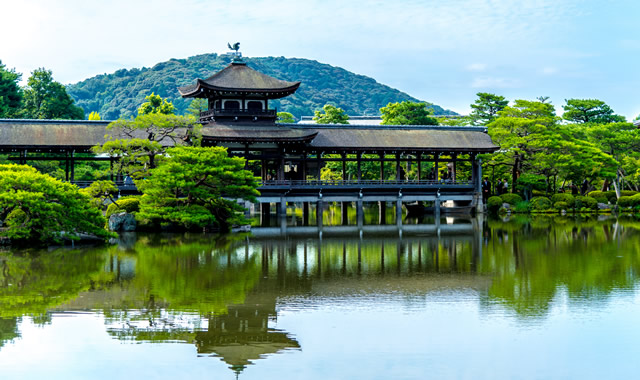- TOP
- Tourist Attractions
Tourist Attractions
Shin-en Garden
A Place of Scenic Beauty
Shin-en Garden
The Shin-en Garden within the grounds of the Heian Jingu Shrine is known worldwide as one of the most famous Japanese-style gardens to be created during the Meiji period. The garden surrounds the main shrine building and is made up of 4 parts: the Higashi (East), Naka (Middle), Nishi (West), and Minami (South) Shin-en Gardens. The vast garden, which was designed by the famous landscape gardener Jihei Ogawa VII is approximately 33,000 square meters in size and features a garden style with a path around a pond. It was designated as a Place of Scenic Beauty by the Japanese Government in December of 1975 for displaying the essence of all the gardening techniques that were compiled over the 1,000 years that Heian-kyo (modern day Kyoto) functioned as the capital of Japan.
The magnificent Shin-en Garden features a different yet equally charming side during every season from weeping cherry blossoms in the spring, Japanese Irises in the early summer, autumn foliage in the fall, and snow-covered scenery during the winter. 100 years since it was first created, the garden exists today as a space that invites visitors into the world of the Heian period where they can witness the grandness of nature.
Jihei Ogawa

A famous landscape gardener, also known by his title “Ueji (植治)”, who designed numerous famous Japanese-style gardens during the Meiji and Showa period such as the Murin-an Garden (villa of Yamagata Aritomo) and Maruyama Park.
This garden utilizes the water from the Lake Biwa Canal and the scenery from the Higashiyama region in the backdrop to create a landscape that embodies the grandness of nature. Of the different gardens that constitute the Shin-en Garden, the Naka Shin-en Garden (Souryu Pond) and Nishi Shin-en Garden (Byakko Pond) were completed in 1895 and the Higashi Shin-en Garden was completed in 1916.
Highlight
- Double weeping cherry
(South Shin-en)
- Iris
(West Shin-en)
- Garyu-Bashi
(Middle-Shin-en)
- Taiheikaku
(East Shin-en)
Heian Jingu Shrine

Heian Jingu Shrine
The Heian Jingu Shrine was established in 1895 to commemorate the 1,100-year anniversary of the return of the capital to Heian (modern day Kyoto) and enshrines Emperor Kanmu, the 50th Emperor of Japan who ordered the return of the capital to Heian. In 1940 (the 2,600th year since the first emperor came to power), the spirit of Emperor Komei, the 121st Emperor of Japan and the last emperor to live in the capital of Heian, was enshrined here jointly with Emperor Kanmu. Thus, these figures and this shrine came to be widely worshiped as the deities of Japanese culture. The main shrine building is a replica of the Chodoin, which is the main building of the Heian Palace, built at 5/8 scale of the original. The magnificent stature of the current Heian Jingu Shrine is made up of the various original structures built in 1895 such as the Daigokuden, Outenmon Gate, Soryuro, Byakkoro, Corridors, and Ryubidan Steps that have been renovated or reconstructed over the years. In December of 2010, 6 structures including the Daigokuden were designated by Japan as an Important Cultural Property along with the 24.4-meter high Grand Shrine Gate (Otorii) along the path to the shrine, which was designated as a Tangible Cultural Property.
MAP

Jidai Festival
Kyoto's 3 Most Famous Festivals
Jidai Festival (Held every year on October 22nd)
The Jidai Festival (Festival of the Ages) is known as one of Kyoto's 3 Most Famous Festivals along with the Aoi Festival and the Gion Festival. The festival originates from the grand festivities held from October 22nd to 24th in 1895 to celebrate the construction of the Heian Jingu Shrine.
Citizens who lived in the area also formed a Heian Jingu Shrine religious association during these festivities (this association is made up of groups (Kumi) that are divided by school districts) to help preserve the grand festival along with the structures of the shrine and the Shin-en Garden. This association performed a “Jidai Fuzoku Gyoretsu” (Historic Pageant) on October 25th, the day after the festivities were over, representing the various cultural customs that existed in the years between the Enryaku era and the Meiji period. From the following year, the performance was held on October 22nd, the official day that the capital was returned to Heian and this tradition has continued to this day.
The festival consists of various events held on October 15th and 21st to 23rd but the “Jidai Fuzoku Gyoretsu” (Historic Pageant) held every year on October 22nd is considered to be the main event.
Kyoto, Festival of the Ages Building Toni Toni
Kyoto, Festival of the Ages Building
Toni Toni
The official name of the Kyoto, Festival of Ages Building is Toni Toni (written 十二十二 in Japanese). This name represents October 22nd, the day that the capital was returned to Heian as the character 十 stands for 10 (October) and 二十二 stands for 22. This is also the day that the Jidai Festival (Festival of the Ages) is held. This unique name was given to the building in the hopes that it would become a facility where people could learn about and experience the Jidai Festival and so that more people would remember this special date. This facility is an "informational, cultural and commercial complex" meant to spread the Jidai Festival to the rest of the world by giving people a chance to experience the elements of this grand festival that is held once a year. People can experience traditional Japanese culture in many ways here through aspects such as food, souvenir shopping, and entertainment.
More details














